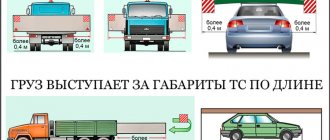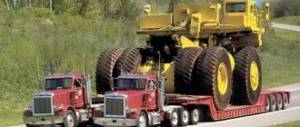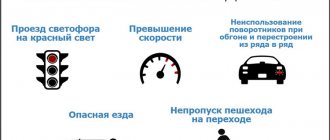Issues discussed in the material:
- What kind of cargo is considered oversized?
- What are the difficulties of transporting oversized cargo?
- How to choose the right route for transporting oversized cargo
- What are the basic rules for transporting oversized cargo?
Delivery of non-standard cargo has some differences, because it weighs a lot, takes up significant space, its center of gravity is shifted, and all standards are exceeded several times. This may make transportation difficult. Therefore, in such situations you have to resort to the help of logistics specialists. However, first of all, it is worth studying what oversized cargo is and how to transport it correctly. Read about this in our article today.
What kind of cargo is considered oversized?
Let’s look at the definition of “oversized cargo”. So, this is an object with impressive weight and huge size. It is impossible to transport this in the usual ways, for example, in a closed truck or closed container.
How to determine that the cargo will be non-standard? To do this, measure its length, width and height. For example, an impressively sized monument, a large boat, or an agricultural tractor are considered oversized cargo; they cannot be transported using conventional methods. The list of oversized cargo also includes: motor boats, graders, agricultural machinery, special devices for drilling wells, all kinds of modules, steam boilers, transformers, that is, objects with non-standard dimensions that exceed all permissible standards.
Transporting oversized, heavy cargo by other means, for example, by train or plane, is not only a financially expensive undertaking, but also difficult to implement in practice. There is only one way out - to transport it by car, which is as convenient and profitable as possible.
Currently, the definition of “oversized cargo” most often includes:
- construction equipment: graders, asphalt pavers, excavators, cranes, beams;
- agricultural machinery: tractors, combines, etc.;
- devices used in industry: boilers, turbines, transformers, reactors, metal processing equipment, presses, injection molding machines, test benches and so on.
Since there is a huge amount of non-standard cargo, it is customary to divide them into several categories:
- Oversized heavy cargo - if it is loaded into a truck, the maximum permitted weight will be exceeded, or the axle loads will be greater than the permissible norm.
- Large cargo - when placed in a truck, any one indicator for the dimensions of the rolling stock will be exceeded several times.
- Long cargo - when transported on a truck, it will extend beyond the tailgate by 2 meters or more.
Considering all of the above, cargo is considered non-standard if its dimensions (taking into account the size of the truck used for transportation) will be:
- above 4 meters;
- longer than 20 meters. According to all standards, a load overhang of 2 m is allowed, taking into account that the length of the object is no more than 20 meters;
- the transported cargo is wider than 2.55 meters;
- the object weighs more than 38 tons.
The most difficult thing is to deliver oversized cargo, the parameters and weight of which exceed all permissible limits. One important thing to keep in mind is that to determine the size and weight of the item being delivered, you must measure it with the truck in mind.
To transport oversized cargo in Russia, special permits will be required. Moreover, the rules for transporting oversized goods prescribed by law must be observed. It is extremely important to correctly position and secure non-standard cargo during transportation on a vehicle.
Delivery of oversized cargo is a difficult and labor-intensive task. Therefore, later in the article we will analyze the main difficulties and problems that may arise in such a situation.
Oversized: types and features
Heavyweights are those products whose mass, together with transport, exceeds the permissible norms. There are also products that are difficult to transport due to their large length. This includes products that protrude two meters or more beyond the rear side of the vehicle. Loads with increased width or height are also oversized. Their sizes significantly exceed standard values. Thus, oversized cargo includes:
- long;
- heavy;
- large-sized.
Regulatory documents indicate a clear list of product parameters acceptable for transportation. Thus, the length of the transported cargo should not exceed twenty meters, width - 255 centimeters, height - four meters. As for weight, the mass of the product together with the transport used cannot be more than 38 tons. Those products that exceed at least one parameter are considered oversized.
Difficulties in transporting oversized cargo
By definition, working with oversized cargo is a special type of transportation. To successfully complete such a complex delivery you will need:
- Choose a suitable vehicle for the delivery of oversized cargo.
- Remember about the specifics of the regions through which you will have to pass.
- Choose a convenient transportation route to save money and time.
- Calculate the duration of transportation.
- Take into account all possible difficulties that may arise during delivery.
- Calculate how much money you will spend on transporting such cargo.
- Sign all necessary documents.
It is recommended to use the services of logistics specialists so that the transportation of oversized cargo in Russia is successful and the delivered item is not damaged.
What documents regulate transportation?
Section 23 of the Traffic Regulations, consisting of five points, is devoted to the transportation of non-standard and dangerous shipments. They reflect all situations that arise during delivery by road.
Key points:
- 23.1 – on the correspondence of the mass of material assets to the maximum load permissible for a vehicle.
- 23.2 – about the driver’s obligation to control the placement of the load while driving.
- 23.3 – about the conditions under which transportation of non-standard items is permitted.
- 23.4 – rules for the transportation of large cargo
- 23.5 – on the need to comply with special rules when transporting heavy and dangerous items.
A driver who does not comply with these points will be required to pay a fine. For their violation there is a more severe punishment - suspension of the operation of transport.
In addition to traffic regulations, documents regulating the transportation of oversized cargo include:
- Government Decree No. 272 of April 15, 2011.
- Order of the Ministry of Transport No. 258 of July 24, 2012.
- Order of the Ministry of Transport No. 7 of January 15, 2015.
The documents contain requirements for the transportation of large cargo, loading, stowage, and route development taking into account the characteristics of the shipment.
Legal basis for transportation of oversized cargo
Today, there are certain norms and laws that regulate the transportation of oversized cargo in our country. These must be strictly adhered to to ensure legal transportation.
First of all, moving a truck with oversized cargo along the roadway must take into account the Traffic Rules. If at least one violation is detected, it will be necessary to pay a fine in the prescribed amount.
Recommended reading:
- Secrets of moving apartments
- Transport loading works
- Moving to Moscow
In addition to the Traffic Rules, take into account the Rules for transporting cargo by road, and also study the Instructions for the delivery of oversized cargo by road on the territory of the Russian Federation. These regulations specify the rules and principles according to which you must organize the transport of large and heavy cargo. The technical requirements for the trucks used are also specified here, and the legal features of transportation are indicated.
Regulatory documents
As you can see, only a small fraction of the aspects of transporting oversized goods are covered by the Road Traffic Rules. Basic regulation of the transportation of oversized cargo on the roads of the Russian Federation is carried out by Federal Law No. 257-FZ. In Chapter 5 of Article 31 you can find the following points:
- transportation of large and heavy cargo requires special permission;
- the procedure for obtaining a special permit is established by the government of the Russian Federation;
- Before transportation, it is necessary to coordinate the route with the owner of the roads;
- In case of damage, the amount of compensation is calculated by the owner of the road.
Based on the rights specified in the above-mentioned normative act, the “Rules for the carriage of goods by road” were drawn up. In this document you can find instructions regarding the procedure for organizing transportation, ensuring the safety of vehicles and containers, if necessary, conditions of transportation and provision of vehicles for transportation.
Related orders and regulations
In order to be guaranteed to protect yourself from problems when filling out an application for a special permit and directly when transporting oversized cargo, we recommend that you familiarize yourself with the following orders:
- No. 107: represents regulations for government agencies for issuing permits;
- No. 258: regulates the rules for issuing permits;
- No. 7: establishes rules to ensure safety when transporting oversized items.
Resolutions:
- No. 125: procedure for weight and dimensional control;
- No. 934 + No. 12: procedure for compensation for damage caused to the road;
- No. 125: rules for passing weight control;
- No. 211: establishes the rules for introducing a ban on cargo transportation.
Fines and punishments
To familiarize yourself with the amount of penalties imposed for violations of the rules for the transportation of oversized cargo, read Article 12.21.1 of the Code of Administrative Offenses of the Russian Federation. There you will find out exactly who should be punished for violations. For example, for not having a special permit, a driver can receive a fine of 2 thousand rubles, but, even worse, he can lose his driver’s license for up to six months.
What traffic regulations say about oversized cargo
Paragraph 23.5 of the traffic rules states that a truck is marked with special distinctive signs.
Let's look at the main signs used during the delivery of oversized items:
- A road train sign is required for a truck that has one or more trailers. It looks like three glowing lights (triangle) placed on the roof of a truck. This sign should be turned on after sunset or when visibility on the road is poor.
- A “Large Load” sign is required when the item being transported is located outside the truck, protruding 1 m from the rear and no more than 40 cm from the edge. The sign is coated with a special compound that reflects light so that it is better visible at night or in poor visibility. It is made in the form of a white and red square made of metal or plastic; the dimensions of the sign are 40 by 40 cm. The width of the stripes is 5 cm.
- The “Long Vehicle” sign is located on the rear of the truck if the dimensions of the latter exceed 20 m. It is made in the form of a rectangular yellow shield with a red border. The dimensions of the sign are 120 by 20 cm. If it is not possible to install such a sign, you can use 2 identical signs with dimensions of 60 cm by 20 cm.
What other signs might there be for oversized cargo? When visibility is poor (at night, at dusk or in the presence of fog), a white light or reflector is placed on the nose of the vehicle. A reflector or red light is installed at the rear of the vehicle. These steps must be performed while traveling on public roads.
What other traffic rules exist that are important to follow when transporting oversized cargo in Russia:
- Transportation is allowed on special trucks.
- The final weight, taking into account the passengers in the vehicle and the cargo being transported, should not exceed the weight established by the manufacturing company that produced the truck.
- The driver should monitor the position of the load while driving on public roads.
- Government authorities establish special rules for the transport of dangerous and extra-large items. They are marked with special signs to make them easier to identify.
How to transport oversized cargo by road without violating traffic regulations?
Special rules for transportation by road apply to oversized cargo. This must be taken into account not only by companies, but also by private car owners.
Signs of oversize
According to the rules of transportation for road transport, oversized cargo is considered to be cargo that does not fit into a standard vehicle. This exceeds the dimensions provided for in GOST:
- width - up to 2.55 m;
- length - up to 20 m;
- height - up to 4 m.
If the parameters of the cargo protrude beyond the boundaries of the vehicle by more than 1 meter in front or behind, as well as 40 cm on the sides, or the height is more than 4 m, then such cargo is considered oversized. In this case, the load experienced by the axle cannot exceed the parameters displayed in the technical documentation by the manufacturer of the car or trailer. Examples of oversized cargo: light vessels, mining excavators, drilling rigs.
In order to carry out oversized road transport by freight transport, you need a set of appropriate conditions, which presuppose:
- availability of rolling stock that meets all technical parameters;
- suitability of transport infrastructure;
- other safety conditions, which include the parameters of bridges, tunnels, location and design features of power lines and communication lines, time of year, highway condition, and others.
Documents regulating the field
In Russia, several regulations regulate such cargo transportation. In particular, these are traffic rules. Transportation of oversized cargo by truck/car is also regulated by orders of the Ministry of Transport.
These documents indicate the limits after which the cargo is classified as Oversize, and the maximum possible dimensions that allow the use of vehicles to move it. It also describes how to safely transport oversized cargo. The documents are quite voluminous and therefore require thorough study.
Speed mode
Speed limits for moving oversized cargo are:
- on roads - up to 60 km/h;
- on bridges - up to 15 km/h.
Marking of oversized cargo
At the extreme points of such a load, special signs are installed - metal shields or stickers with an area of 40x40 cm. They depict alternating diagonal stripes of white and red colors. Reflective paint is used to apply the image, allowing other drivers to see the markings even in the dark.
Signs are also posted:
- road train;
- large size;
- length
When moving a load in the dark, its edges are indicated by reflectors or white lighting in the front, red or orange in the rear.
Permission
Transportation of oversized cargo by road transport, according to the rules, requires a permit. For international transport it is issued by the Federal Road Agency of the Ministry of Transport. For transportation within the country, such a document is obtained from the authorized bodies through whose territory the route runs. This is Rosavtodor, as well as the authorities of the subject of the federation, municipality, settlement, etc. If the road is private, then it becomes necessary to coordinate the route of movement with its owner.
When issuing such a permit for the transportation of oversized cargo, the route of the vehicle is agreed upon by the authorities with the owners of those objects that may interfere with transportation. Such structures include bridges, tunnels, power lines, etc. When moving across railway lines, coordination with the head of the track distance and power supply is also necessary.
According to the requirements for the transportation of oversized cargo by road, the validity period is limited to one trip or a certain time period, subject to repeated transportation of the same type. The document is issued in the form of a card. It is mounted at the bottom right of the windshield of the tractor. If there is a need to change the route on the road, a separate permit is required for this. The absence of this document is fraught with serious penalties.
Escort
When transporting oversized cargo by motor transport across Russia, in a number of cases the rules provide for the need for the vehicle to be accompanied by road patrol authorities.
The grounds for assigning escort are:
- dimensions of a vehicle with a load longer than 30 m, width - from 4 m;
- if the vehicle at least partially occupies the oncoming lane;
- there is a possibility of prompt organization of traffic.
Escort is a paid service, which the carrier includes in its costs.
Cover car
According to the rules, for the transportation of oversized cargo, escort by road is required if the dimensions of the main vehicle are as follows:
- width - 3.5–4 m;
- the length of the road train is 24–30 m.
A corresponding entry is made in the “Special traffic conditions” column.
A yellow or orange flashing light is installed on the accompanying vehicle. The covering vehicle moves with a ledge to the left, warning oncoming vehicles about the possible danger associated with the transportation of oversized cargo.
Driver's responsibility
If at least one of the prescribed rules for transporting oversized cargo in a car or truck is not observed, the driver is obliged to stop driving and eliminate the violation. If traffic rules and other documents regulating the transportation of such items are ignored, sanctions may be applied:
- a monetary fine for both the driver and the officials who committed the violation;
- temporary deprivation of the right to drive a car;
- detention of a vehicle.
For passenger car
Rules for moving oversized cargo have also been adopted for passenger vehicles. In addition to the size restrictions mentioned above, the following rules apply:
- the permissible weight of what is transported in the trunk is no more than 100 kg, otherwise damage to the pillars and roof is likely;
- the load should not limit the degree of vision coverage for the driver, obscure or impair the readability of government signs, block headlight illumination, or protrude beyond the limits indicated above;
- the transported items should not affect the stability or make it difficult to control the transport;
- loads are securely secured to prevent accidental falling or slipping;
- a loaded machine does not create noise, does not raise dust and does not harm the environment.
It is prohibited to transport cargo in the cabin if it interferes with vehicle control. On the road, you need to periodically stop and check the reliability of the fastening.
If the cargo being moved blocks the rear view, then it is permitted to be transported if rear-view mirrors are installed on both sides of the vehicle.
Ban on transportation of Oversize cargo
Transportation of oversized items is refused if the cargo to be moved can be divided without loss of operational properties. Such categories of cargo are not allowed to be transported in organized convoys.
Experts who develop standards for road users say that the instructions are written in the blood of victims. Therefore, all types of vehicles for transporting oversized cargo must strictly comply with the prescribed rules. Someone's life may depend on it.
Escort of oversized cargo
Until 2014, companies involved in cargo transportation independently provided conditions for transporting goods whose dimensions were more than 24 meters, but did not reach 30 meters, with a width of 3.5 to 4 meters. Now, for this, you will need to connect the traffic police to ensure safe transportation and connect a cover vehicle that accompanies the cargo during its delivery.
The vehicle accompanying the oversized cargo must meet the following requirements:
- there is an orange-yellow stripe on it;
- it is equipped with flashing orange-yellow beacons;
- such a machine has a reflective or light screen. It warns other road users that oversized items are being transported. For example, this could be the inscription: “Long length.”
Preparation for transportation of oversized cargo
To avoid unforeseen situations when transporting oversized items, you will have to think through all the details and anticipate problems that may arise. When choosing a transportation strategy, pay attention to such points as:
- contacting logistics and transportation specialists;
- equipping trucks, railway and water transport, forklifts and so on;
- features of operated roads, railways, and waterways. Think about what is best to use in case of an emergency during the delivery of oversized cargo;
- requirements for the quality of transportation of oversized items;
- volume and time of transportation;
- the budget you will spend on organization and transportation itself;
- whether anything will need to be agreed upon, including at the state level.
Knowing the characteristics of transported large-sized or heavy items, carry out all the necessary actions to organize and technically equip cargo transportation, use the most effective technology to ensure that transportation is successful, without material and time losses.
The cost of transporting oversized cargo by road
After studying the rules for transporting oversized cargo by road, it becomes clear that there is no single tariff for the provision of such services. In each individual case, the cost of transportation is calculated individually. The following points may affect the final price of transportation:
- model of vehicles used to deliver large or long cargo;
- difficulty of transportation;
- uniqueness of the cargo;
- length of the transport route;
- urgency of delivery.
To avoid problems that may arise during the international transportation of oversized items, you need to carefully consider each stage of delivery. Well, since this is one of the most difficult logistics tasks, turn to professional freight forwarding companies for help.
Choosing a route for transporting oversized cargo
Since the truck moves on public roads, you will have to select the most convenient transportation route depending on the congestion of the roadway and the speed allowed in a particular area. Pay attention to the specific features of the route used: is the surface good enough, how large is the slope, what is the width of the road, are there any bridges that you will have to cross, or railway embankments, crossings and other obstacles that interfere with the normal delivery of large items.
That is, when choosing the best route from the place of departure to the destination, you should clearly understand all possible travel routes. Have you found 2-3 optimally suitable routes? Consider all the pros and cons of each before deciding and choosing the best one.
How do logistics professionals determine the best travel option when delivering large items? First of all, they adhere to one, most important principle: the shortest travel time. But when working with oversized cargo, you will have to take into account such nuances as possible obstacles on the route - bridges and railway crossings that will have to be overcome, the distance of the road from cities and other populated areas, weather conditions, season and time of day.
So, if the proposed route is laid through the city, then you will have to take into account the specific rules for transporting oversized, heavy and bulky cargo.
For example, you can move around the city with oversized cargo only at night, so that the highway is not congested: this way you will not interfere with other road users. Moreover, there are often cases when truck escort is required (for example, in the case of transporting oversized agricultural machinery). It is clear that this also needs to be agreed with the traffic police.
To determine the best route for transporting oversized cargo, consider characteristics such as:
- features of the truck used;
- characteristics of transported large-sized and heavy items, specific transportation conditions;
- the composition of the institutions that will coordinate the route and control the transportation of oversized items;
- stages of cargo delivery operations;
- responsibilities of the parties to the transaction.
The transport company and the client submit all necessary data and documents to the road organizations. This is necessary in order to prevent the road surface from being unsuitable for transporting oversized cargo. So, interference can be: the presence of electrical wires, bridges, and the like. In each individual situation you will have to find an individual solution.
Do not forget that planning a route for transporting dangerous goods should be taken seriously. Otherwise, unforeseen situations may arise. The next step is to begin coordinating the route with road organizations, where you will be given permission to transport non-standard items.
Preparation of documents for transportation
In order to transport oversized cargo without problems, you will need to correctly prepare all the necessary documents. The Ministry of Transport Instructions contain all the basic rules for registration.
It contains parameters as well as cargo classification. All oversized cargo is under strict control of the traffic police, which means that it will not be possible to transport anything without documents.
We obtain permits from the Federal Road Agency.
We provide a package of documents including:
- statement;
- movement diagram;
- vehicle inspection (with tractor and semi-trailer);
- registration certificate for the dimensions of the transported item.
We will analyze in detail the permitting documents for the transportation of oversized goods. Transported items will have to be processed according to the rules for transporting large and heavy cargo, as well as taking into account traffic regulations and the like. If the length of the transported item is too long or the cargo is oversized, you will have to additionally attach a special permit.
Order No. 258 determines the rules for obtaining permits for transportation. It states:
- features of admission, as well as the reasons why you may be refused;
- rules for writing and submitting an application;
- description of documentation;
- features of coordination of transportation of oversized heavy cargo;
- the time within which you are required to provide a permit;
- the procedure for granting special permission, as well as the reasons why you may be refused.
Special permit for transportation of oversized cargo
If the item is large or heavy, it can be transported if the owner of the roadway gives his consent. You will be given a special permit only if there are no other means of transportation, for example in parts, by plane or by rail.
This document states:
- when the application was received and when the permit was issued;
- type of transportation;
- category of the item being transported;
- route;
- the period for which the document was issued;
- with whom the permission was agreed upon;
- vehicle registration number;
- name of the transport company, address, telephone number;
- payment amount, date and payment document number;
- number of the permit, date of issue;
- signature of the person who issued the permit;
- signature of the person who received it.
A special permit is a guarantee of safety for the owner of the highway. During transportation of oversized cargo, bridges, viaducts, power lines, forest roads, and the like may be damaged. The transport company takes into account the buildings located on the highway and on the sides, in addition, if the owner of the road allows, the wires can be raised for passage.
First of all, you should obtain permission to transport oversized cargo from the owners of small highways, only after that you can apply for permission to travel on large highways. If you are a citizen of another country, the approval will be carried out by the road department.
The special permit applies to a specific route and for a specific load. If the route changes, you will have to obtain a permit again.
In order to obtain a special permit to transport a non-standard item, it will take a lot of time, up to 2-3 weeks if you are transporting cargo from another country. So, to issue this document in Estonia, Finland or Sweden, it will take a couple of days, but in our country it can take up to three weeks. Moreover, the price for a special permit should be added to the cost of transportation. To receive it, you submit a petition to the owner of the track. Keep in mind that the later the application deadline, the higher the cost of the permit.
In a situation where the transport company refused to transport oversized items and returned the special permit before the travel date, you can return half of its cost. However, no one will return the money for registration. Changes to the permit can be made when the issuing organization has been warned about this in advance.
It is prohibited to transport non-standard items if they can be taken away in parts. When issuing a special permit, the transportation company must specify the dimensions of the cargo. If there is an error of, for example, 10 cm, you will have to spend a lot of money.
The carrier must also inform the customer that his goods are oversized. It also happens that a person does not know about it. Most often, it is the carrier company you contact that receives the permit. In the application for a special permit, it is necessary to note not only the data of the applicant and the transport company, but also information about the truck: its type, make, license plate number, axle load, distance between the axles.
When the object being transported is wider than 6 m, the applicant contacts the police department, where they will determine whether additional escort is required to prevent accidents on the road. Control of such transportation is carried out by the road department, the police, as well as the owner of the roadway.
When checking the item being transported, the police may find out that there is no special permit. In this case, the vehicle will be stopped and stored. It does not matter which country the carrier comes from.
Documents for the transportation of oversized items can be completed with the client’s consent. If everything is legally documented, your oversized cargo will be insured against emergency situations on the road.
Cargo transportation
Large cargo can be transported if the following procedures are followed.
For transportation, you must obtain special permission from the regulatory authority in advance. An application for its issuance is considered by an authorized person within 3-4 days. This period may be extended to 30 days if transport is possible only after changes to the original design.
The regulatory authority may not issue the required permit. This is possible in cases where:
- Large cargo can be disassembled into separate parts of standard sizes.
- It is impossible to ensure safety during transport.
- It is possible to transport cargo in a safer way (for example, by plane or by rail).
In some situations an accompaniment must be provided. Such cases include:
- The width of the vehicle with a load is more than 4 m.
- Length exceeds 30 m.
- The carrier occupies some part of the oncoming lane.
- In the event of a change in transportation conditions in order to maintain traffic safety.
The accompanying vehicle must meet the requirements imposed on it to ensure traffic safety. It must be equipped with orange flashing lights. It must move at the distance established by traffic regulations from a truck (or car) that is transporting oversized cargo.
The object of transportation can be any product, including clothing, furniture, building materials, sports products, metal structures, various equipment, etc. Currently, transportation of oversized cargo is a popular service, due to the large number of products with increased weight or size. In such cases, it is not possible to use standard shipping. To transport oversized cargo, you must have not only special equipment, but also permits. What products belong to this type of cargo?
When transportation of oversized cargo by road is prohibited
Let's look at situations when it is impossible to transport non-standard cargo by car:
- The object being transported interferes with the driver.
- An oversized vehicle loses stability. Weather conditions and the presence of squally winds should be taken into account - they complicate the situation and are additional factors that contribute to the machine overturning.
- Oversized cargo prevents the carrier from seeing the situation on the road, which can lead to disastrous consequences.
- Non-standard cargo covers lights, reflectors, identification marks, and vehicle license plates.
- Transportation of oversized cargo has a detrimental effect on the environment.
Oversized cargo: definition
This term refers to a vehicle (with or without cargo) that exceeds in its overall dimensions the values established by regulatory documents. Thus, the transport affinity should not exceed 20 m in length, 2.55 m in width, and 4 m in height. With such dimensions, the total weight of the vehicle and cargo should not exceed 38 tons.
It is clear that lighter and smaller cargo is easier to transport and, accordingly, cheaper. Therefore, transportation of large-sized cargo is considered simpler if the dimensions are within the following limits: length no more than 2 m extends beyond the edges of the vehicle, width - up to 3.5 m, height - up to 4.5 m.
Main rules for transporting oversized cargo
Follow these guidelines to successfully transport oversized cargo:
- The speed of a loaded vehicle is no more than 60 km per hour.
- The speed on the bridge should not exceed 15 km per hour.
- After driving a certain distance (for example, 500 km), the driver should make sure that the vehicle is in good condition.
- An oversized trailer is equipped with a working parking brake system. In addition, there must be equipment to provide braking to the trailer if the air brakes from the towing vehicle fail.
- Oversized items should be well secured. In this case, the fasteners should be checked regularly.
The next difference between this type of transportation is the presence of working brakes. According to the requirements, the brake pedal in a road train is placed on the tractor, while the semi-trailer is equipped with parking brakes. In case the lines break, the vehicle is equipped with a special device for automatic braking. A road train carrying oversized cargo must be equipped with a recoil mechanism, and additional rear-view mirrors are placed on the cabin.
When a vehicle is not equipped according to the rules, the carrier must eliminate the identified discrepancies. Otherwise the vehicle will be stopped.
Important! Specialists will be able to properly secure oversized items, taking into account its size and center of gravity. For transportation to end successfully, the object is transported in balance. It is possible to keep non-standard cargo intact if you take into account its features, secure it correctly and load it.
Restrictions on transportation of oversized cargo
In some cases, it is prohibited not only to transport oversized cargo, but also to stop. For example, you cannot:
- drive in conditions of poor visibility - up to 100 m, during icy conditions;
- exceed the speed permitted for this type of cargo;
- move during low visibility;
- driving during a storm or heavy snow.
- move along the side of the road;
- transport oversized items if the fastenings are faulty;
- move when the load is not secured, it has shifted;
- transport oversized items, the weight of which is higher than permissible for a given vehicle;
- transport an object that prevents the carrier from monitoring the road or driving the vehicle;
- carry an object that blocks light fixtures or reflectors;
- transport oversized items that destroy the road, causing a lot of dust and noise;
- make stops where there are no special signs permitting parking.
Note! If you are shipping oversized items overseas, you should consider foreign shipping regulations.
Carriage ban
Let's look at the cases in which transportation of oversized items is prohibited:
- the load interferes with driving;
- with a load the car becomes unstable. To prevent a truck from tipping over, it is imperative to take into account seasonal characteristics and the risk of exposure to heavy winds;
- due to the size of the object, the driver’s visibility is limited, as a result of which he cannot adequately assess the road situation;
- the cargo covers lighting fixtures, reflectors, identification marks, and state license plates;
- During transportation, environmental pollution occurs.
Liability for violations during the transportation of oversized cargo
Traffic rules regulate the transportation of non-standard cargo. Any difficulties can be resolved with the traffic police, but if transportation occurs from another country, then with the Ministry of Transport.
If a violation is detected, the carrier undertakes to pay a fine. Its magnitude is determined by how severe the violation is and its consequences.
If illegal transportation of such cargo without a special permit was detected, administrative liability will be applied (Article 12.12 of the Code of the Russian Federation on Administrative Offenses) and a fine will be imposed:
- for an individual - from 2,000 to 2,500 rubles;
- for officials - 15,000 to 20,000 rubles;
- for legal entities - from 400,000 to 500,000 rubles.
In addition, the person driving the vehicle may be deprived of his license for 4-6 months.
If a legal entity or individual needs to transport a non-standard item, the relevant rules and regulations should be followed. Otherwise, a fine will be imposed and the driver will lose his license. You cannot transport oversized cargo in a broken car, or hire an inexperienced or unhealthy driver. After all, it is this person who bears all the responsibility for the safety of not only the cargo, but also other road users.
Transportation of oversized cargo by car
It is not uncommon for cars to transport oversized cargo that protrudes above the road. The driver of such a vehicle may also be punished for failure to comply with transportation regulations.
Which item will be recognized as oversized cargo transported in a passenger car:
- if it protrudes 1 m behind or in front of the car;
- if it protrudes from the side by 40 cm.
Do you need to transport oversized cargo in a passenger car? You will have to use a warning sign, placing it on a protruding area of the item being transported. In addition, in the dark, install light reflectors: white in the front of the car, red in the rear.
Position the item so that the view from the driver’s seat remains good; oversized items must be well secured and should not damage the roadway or other structures.
It is prohibited to transport oversized cargo on a passenger car if it protrudes from the front and rear by 2 m, and its width is more than 2.55 m. In this situation, a special permit is required. If stopped by a state traffic inspector, you may be issued a report and deprived of your license for a period of 6 months.
International and transportation of oversized cargo within Russia
To transport goods outside the country, you must show a special permit document at the border. Without a special document, the vehicle will be detained.
Federal Law No. 127-FZ regulates the international transportation of “oversized” goods. Special permission can be obtained only for 1 flight (one-time). It must be obtained from the Federal Treasury Authority “Rosdormonitoring”.
To obtain permission to transport oversized cargo outside the country, you need to write an application to Rosdormonitoring or register on the State Services website and submit the appropriate application. Such documents can also be obtained through companies providing such services (intermediaries).
An interregional permit must be obtained if you have to cross two or more territorial units of the upper level of the Russian Federation. An interregional permit can also be obtained through the State Services website or by writing an application at one of the offices of the Road Management Department of the Russian Federation.











